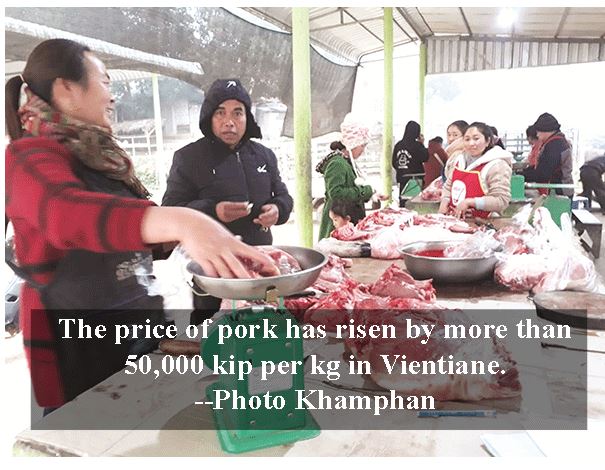Laos: Inflation down, but financial hardship persists
Although inflation is trending downwards, many people feel their personal situation has not improved at all due to the mismatch between their income and spending.
Many Vientiane residents say their income has not increased but prices are continuing to rise, ramping up pressure on their families and making it difficult for them to improve their quality of life.
For instance, the price of pork, which is a staple for Lao households, has risen by more than 50,000 kip per kg despite the government’s efforts to put a ceiling on the market price.
According to the Lao Statistics Bureau, the Consumer Price Index (CPI) stood at 113.95 points in January, indicating an inflation rate of 2.01 percent year-on-year, down from the 3.19 percent recorded in December.
Rising food prices and the weakening value of the kip against the Thai baht and US dollar are among the main drivers of inflation.
According to the Lao Statistics Bureau, prices in the food and non-alcohol beverage category surged by 2.38 percent year-on-year.
The price of pork rose by 11.45 percent year-on-year, beef by 8.21 percent, fish and seafood by 1.33 percent, and seasonings by 6.16 percent.
The inflation rate in the clothing and footwear category rose by 0.05 percent month-on-month and 3.8 percent year-on-year. But the cost of women’s clothing surged by 6.19 percent year-on-year.
The cost of household goods went up by 0.32 percent month-on-month and 3.37 percent year-on-year. The price of interior decor items rose by 3.87 percent year-on-year, mattresses and mattress pads by 4.57 percent, and kitchen items by 4.87 percent.
Prices in the medical care category climbed by 0.09 percent month-on-month and 4.35 percent year-on-year, with the cost of medicines and medical equipment increasing by 3.89 percent year-on-year, and the cost of medical treatment in hospitals rising by 2.27 percent year-on-year.
Costs in the communication and transport category rose by 0.31 percent month-on-month and 1.31 percent year-on-year, with the cost of transport increasing by 1.47 percent month-on-month. However, the price of fuel surged by 2.9 percent month-on-month.
Prices in the restaurant and hotel category rose by 0.23 percent month-on-month but dropped by 2.44 percent year-on-year.
As examples of the rise in price of popular food items, the cost of dishes such as noodle soup and laap increased by 0.28 percent month-on-month.
The government forecasted that economic growth would sink to 3.3 percent in 2020 due to the Covid-19 pandemic. The global virus outbreak has disrupted exports, the inflow of foreign visitors and foreign investment in Laos, which are the main sources of foreign currency earnings.
The fluctuating currency exchange rate remains a major concern as most traders base the price of their products on foreign currencies to lower the risk of financial losses.
Source: https://www.vientianetimes.org.la/freeContent/FreeConten_Inflation_32.php


 Thailand
Thailand




